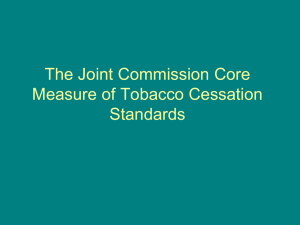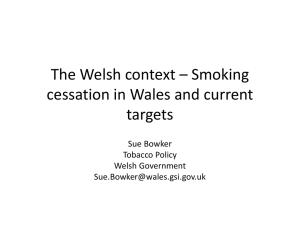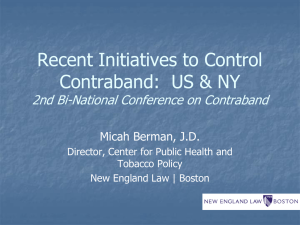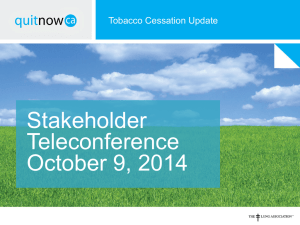FQHC Tobacco Conference and Behavioral Health
advertisement
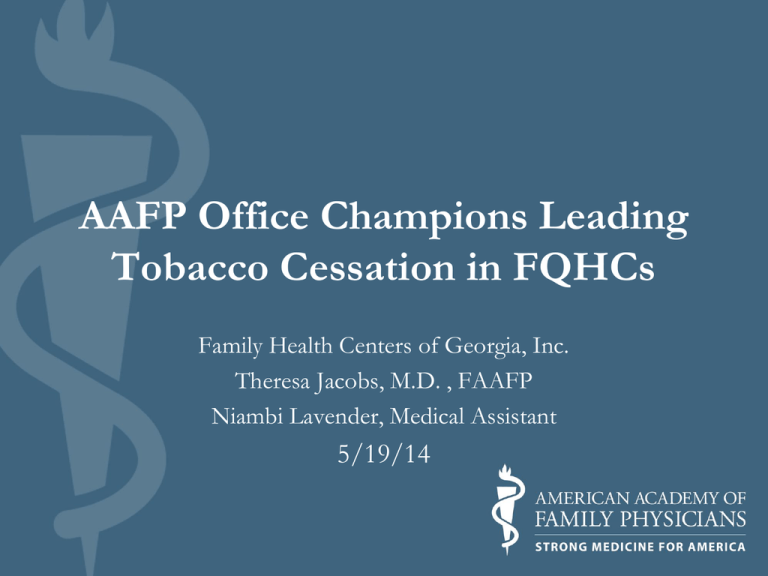
AAFP Office Champions Leading Tobacco Cessation in FQHCs Family Health Centers of Georgia, Inc. Theresa Jacobs, M.D. , FAAFP Niambi Lavender, Medical Assistant 5/19/14 Disclosure • The American Academy of Family Physicians (AAFP) Office Champions Tobacco Cessation Federally Qualified Health Center (FQHC) Project was funded by Pfizer Inc, in collaboration with the Smoking Cessation Leadership Center (SCLC) 2 AAFP Office Champions Tobacco Cessation Project • AAFP recruited FQHCs to participate in the Office Champions Tobacco Cessation Project. An FQHC is a non-profit private or public entity that serves medically underserved populations and/or areas 3 What is Office Champions? A team-focused quality improvement model that incorporates practical, proven strategies: • Develop an implementation plan • Provide training and improve staff collaboration • Initiate systems changes • Increase patient engagement • Evaluate results (chart reviews and surveys) 4 AAFP Tobacco Cessation Resources http://www.aafp.org/patient-care/publichealth/tobacco-cessation/ask-act.html 5 Burden of Tobacco Use The annual burden of smoking-attributable mortality in the U.S. is currently estimated to be 480,000. Millions more are living with smoking-related diseases 6 National Uniform Data System & Office Champions Outcomes 120 96.1 100 80 60 85.6 79.5 74.5 52.7 57.6 % Tobacco Use Screening % Tobacco Intervention 40 20 0 National UDS National UDS 2011 2012 7 Office Champions 2013 Who We Are • Family Health Centers of Georgia, Inc. (FHCGA) began providing comprehensive preventive healthcare in 1976.There are eight locations in Fulton and Cobb counties. Healthcare services include medical, behavioral health, and dental care 8 Behavioral Health Services • FHCGA has a licensed clinical social worker on staff that counsels patients, as needed. All patients 13 and older are screened for depression and referred to behavioral health for in-house counseling 9 Behavioral Health & Tobacco Cessation • More that 1 in 3 adults (36%) with a mental illness smoke cigarettes, compared with about 1 in 5 adults (21%) with no mental illness • The most common behavioral health issues linked to nicotine dependence at FHCGA is stress, depression, and anxiety 10 Clinical Environment • More than 40% of FQHC patients use tobacco, double the national prevalence rate • Health disparities that impact the FHCGA community are: race, low socioeconomic status, lack of insurance, low education levels, and unemployment 11 Office Champion & Physician Champion Role Office Champion • Provide health education to patients • Help develop cessation plans based on health risks • Monitored patient progress 12 Physician Champion • Identify cessation modality • Refer patient to behavioral health counseling • Provide patients with treatment options Team Approach In order for Office Champions to be successful, the practice team must collaborate to meet the common goal of achieving a tobacco-free culture • Effective communication • Staff buy-in • Office & Physician Champions sharing a leadership role 13 Systems Changes • The AAFP Office Champions FQHC project was instrumental in improving clinical practice patterns at FHCGA. The goal was to incorporate cessation into routine workflow and reduce smoking prevalence by 10-20% 14 1) Implementation Plan: Referrals • Patients were referred to behavioral health counselors, case managers, social workers, health educators, and quitlines as needed. In addition, the head pharmacist is a tobacco cessation treatment specialist 15 2) Implementation Plan: Staff Communication/Education • Several health education classes were made available to patients. Workshops offered included the Office Champion as a speaker and offered a table to display with AAFP’s Ask and Act patient education materials and resources to promote tobacco cessation 16 3) Implementation Plan: Marketing • AAFP’s Ask and Act resources including patient education materials, flyers, posters, lapel pins, newsletters, etc. helped to encourage a culture of tobacco cessation 17 Tobacco Cessation 2013 rates at FHCGA • 1,133 patients were enrolled in the tobacco cessation program, 30% of the patients enrolled have reduced cigarettes intake to less than 5 per day, 20% of patients no longer smoke 18 Challenges The barriers that were identified while implementing the changes: • Finding affordable medication for the patients on an individual basis • Working on prior authorization from the insurance companies to use approved medications • Patients that have relapse due to life changes 19 Successes! • FHCGA has initiated a comprehensive tobacco cessation program because tobacco use screening and intervention is extremely effective in both cost and health outcomes 20 Patient Centered Medical Home • FHCGA, whose framework is based on the Patient Centered Medical Home (PCMH), has incorporated tobacco cessation into the workflow • The changes made are sustainable, and now are part of the system to support a tobacco-free culture 21 Achieving Goals • By participating in AAFP’s Office Champions project, FHCGA achieved its goal to incorporate cessation into routine workflow and reduced smokers by 10-20%. For more information on Ask and Act and final report results visit: www.aafp.org/askandact/officechampions http://www.aafp.org/dam/AAFP/documents/patient_care/tobacco/officechampions-final-report-2013.pdf 22 23 Thank You! Questions ? Theresa Jacobs, M.D., FAAFP trjacobs1@yahoo.com Niambi Lavender, Medical Assistant nlavender@att.net Christy Alexander, MPH American Academy of Family Physicians Project Specialist TempPR@aafp.org 913-906-6000 x 3140 24

